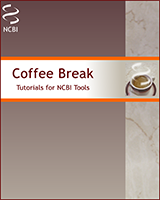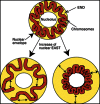NCBI Bookshelf. A service of the National Library of Medicine, National Institutes of Health.
Dean L, McEntyre J, editors. Coffee Break: Tutorials for NCBI Tools [Internet]. Bethesda (MD): National Center for Biotechnology Information (US); 1999-.
What do traditional office skills like filing and book-keeping have in common with cell biology? The answer lies in the organization of essential components — be they documents or proteins — into distinct compartments. Take the nucleus, for example, where the proteins involved in processes such as transcription and RNA metabolism are physically clustered, and chromosomes are partitioned into discrete territories.
Reporting in Nature Cell Biology, Martin Wasser and William Chia from the National University of Singapore describe a molecular secretary that may organize this nuclear filing system in the fruit fly Drosophila melanogaster. Known as EAST (for 'enhanced adult sensory threshold'), it contains 12 potential proteolytic sites as well as seven putative nuclear-localization signals. These characteristics led the authors to propose that EAST is an unstable protein targeted specifically to the nucleus.
To test this prediction, Wasser and Chia studied the expression pattern of EAST in giant nuclei from Drosophila salivary glands. Confocal microscopy captured images of EAST in a region that the authors refer to as the extrachromosomal nuclear domain (END), which, as its name suggests, is the area around and between the chromosomes. Similar compartments have previously been detected in other organisms, where they are thought to belong to a putative nuclear endoskeleton.
What might be the function of EAST within this 'nucleoskeleton'? The authors reasoned that, if it is involved in forming a structural backbone, EAST may recruit other factors to the END. So they studied the effect of disrupting the east gene on distribution of a protein called CP60 that normally co-localizes with EAST. Consistent with their ideas, the CP60 expression pattern was destroyed. What's more, Wasser and Chia found overlapping expression patterns between EAST and nuclear actin — a satisfying discovery given that, outside the nucleus, actin is a core structural component of the cytoskeleton.
Overexpression of EAST gave equally striking results - an expansion of the END. This effect, which can also be induced by heat-shocking Drosophila, results from accumulation of the extra EAST. But as the figure shows, the consequences of expansion vary depending where the END expands: if EAST accumulates mainly between the chromosomes (left), the effect will be to increase the spacing between them; expansion between the chromosomes and nuclear membrane (right), however, will compress the chromosomes. In either case, this could prevent the random collision of neighbouring chromosome arms when cells are under stress.
Wasser and Chia have shown, then, that EAST is a nuclear architect involved in the assembly of an expandable nucleoskeleton between chromosomes. The next steps will be to work out how increased levels of EAST cause the END to expand, and to take a closer look at how the EAST protein is regulated.
Story contributed by Alison Mitchell, Nature Reviews Molecular Cell Biology
Search the Drosophila genome for CP60
Created: June 16, 2000
Click on the link below to start an html tutorial.
Find CP60 in the Drosophila genome
- GeneLocus Links
- The beginning of the END - Coffee BreakThe beginning of the END - Coffee Break
Your browsing activity is empty.
Activity recording is turned off.
See more...

